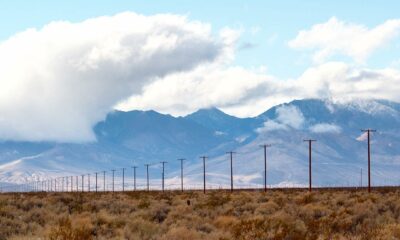Executive
The UN and the Biden Administration Want Net Zero for the U.S.—While China Opts for Energy Realism
The Biden administration collaborates with the UN to mandate net zero emissions for the United States, while China gets a pass.

Six days after this November’s presidential election, the annual United Nations climate change talks will take place in Baku, Azerbaijan. Unlike the election, no one is holding their breath. Baku will be the twenty-ninth in the series. Climate change regularly draws gatherings of world leaders like no other. When the U.S. president shows up, everyone who is anyone turns up, too. These events often represent milestones in the upward ascent of global climate action. In the beginning, there was the 1992 Rio Earth Summit, attended by President George H. W. Bush. Then came the Kyoto Protocol, with President Bill Clinton shrewdly sending Vice President Al Gore to Japan. The 2009 Copenhagen climate summit (attended by President Barack Obama) is memory-holed; that’s when China, along with India, Brazil, and South Africa, vetoed a binding climate treaty, redeemed by the 2015 Paris climate agreement (President Obama again).
China stopped a Copenhagen Agreement from passing
Yet the only year that matters for climate realism is 2006, the year of the great cross-over, when China’s emissions of carbon dioxide overtook those of the United States. This helps explain why China wielded its veto three years later at the Copenhagen climate summit. By 2019, America’s carbon dioxide emissions had fallen by 875 million metric tons from their 2005 peak. Over the same period, China’s rose by 3,511 million metric tons. Twelve years of falling American carbon dioxide emissions were erased by three years of rising Chinese emissions.
Source: https://ourworldindata.org/co2-and-other-greenhouse-gas-emissions
This leads to a reality check about America’s climate policy as practiced by Presidents Obama and Joe Biden. In terms of the amount of human-induced carbon dioxide going into the atmosphere, what America does or does not do is of decreasing significance. The emissions math nullifies the claim of solipsistic climate activists that unless the U.S. drives its emissions towards zero, various forms of climate catastrophe will be visited on Americans. But here’s the rub: even though America’s emissions account for a rapidly declining proportion of global emissions, the negative economic impact of climate policy on the U.S. economy, on jobs, and on Americans’ standard of living is growing.
The British learned a bitter lesson about net zero
The U.S. could learn from the example of Britain, the poster child of climate leadership. It was the world’s first major economy to adopt binding emissions reduction targets when parliament passed the Climate Change Act in 2008. Initially, the Act required an 80 percent reduction in greenhouse gas emissions by 2050. In 2019, the target was raised to 100 percent by 2050, a target that the Biden administration also adopted in 2021. As in the U.S., the prime target for decarbonization is electricity generation, to be achieved in Britain through a mix of cap-and-trade; huge subsidies for wind and solar power, funded by consumer levies rather than by the taxpayer; and anti-coal regulations, a strategy also adopted by the Obama and Biden administrations.
As a laboratory for net zero, Britain’s experiment with renewable energy provides unambiguous evidence that wind and solar increase the cost of electricity. Although the cost of coal and natural gas used in Britain’s power stations was flat between 2009 and 2020, residential electricity rates in Britain soared by 67 percent, to 17.9p (23.4¢) per kilowatt hour (kwh) – 75 percent more than the average 13.5¢ per kwh American household paid in 2020. These increases were driven by a near tripling of environmental and social levies and increased spending on the infrastructure needed to connect far-flung wind farms to where people actually live and work.
Intermittency, the great hazard of net zero
Forcing electricity customers to pay for the extra grid infrastructure and the costs of covering for the intermittency of renewables when the sun doesn’t shine and the wind doesn’t blow can make renewables stupendously profitable for investors. Over the period 2009 to 2020, Britain’s Big Six energy companies received an average price of £112.81 ($147.78) per megawatt hour (MWh) from their renewables portfolio – twice the average £56.22 ($73.65) price per MWh from their coal- and gas-fired power stations. Breathtakingly high renewable profits meant that in one year (2017), renewables’ £54.93 ($71.96) profit per MWh was higher than the £52.47 ($68.74) average price per MWh that the Big Six earned from their thermal power stations.
Aggressive use of carbon taxes to penalize fossil fuel power generation and force coal off the grid (“powering past coal”) saw the Big Six incur £1,603m ($2,100m) in losses and write-downs on their coal and gas power stations in 2014. Over-rewarding renewables led to over-investment in renewables and nearly zero investment in new power stations needed to keep the lights on. In 2009, Britain had 18.6 gigawatts (GW) of non-intermittent (i.e., reliable) generating capacity for every 1 GW of intermittent (i.e., unreliable) wind and solar. Eleven years later, that had fallen to 1.7 GW of non-intermittent capacity for every 1 GW of wind and solar, a dangerous level that will worsen unless and until Britain abandons net zero.
The capacity market
To try and address wind and solar intermittency, the previous government created a capacity market so that power stations get paid for making their capacity available on demand. Capacity markets turn out to be an astonishingly expensive way of generating electricity. In 2020, electricity consumers paid an average of £224.31($293.85) per MWh to German-owned Uniper for electricity from its coal-fired power stations. This illustrates one reason why a renewables-heavy grid produces more expensive electricity. It requires having two parallel generating systems – intermittent renewables and firm back-up. This is reflected in the deteriorating capital efficiency of Britain’s grid. Between 2009 and 2020, each GW of generating capacity produced 28.5 percent less electricity than it had eleven years earlier because of the influx of wind and solar capacity.
Producing less energy with more capital is the essential fact of the energy transition. This reverses the economic growth paradigm since the onset of the Industrial Revolution. Improved capital productivity – getting more from less – alongside higher labor productivity and product innovation is a key driver of long-term economic growth. In capitalist economies, capital, just like labor and other inputs, is a real cost. Yet the metric commonly used to compare renewables and non-intermittent power stations, the Levelized Cost of Electricity, excludes the negative impact of adding more renewables on the capital efficiency of the whole system – one reason why claims about renewables being cost-competitive should be treated with a pinch of salt.
Killing new investment in conventional power
Having more renewables not only pushes up costs but also has the countervailing effect of degrading the value of the electricity they generate. Because renewables have no fuel input costs, on days when there’s lots of wind or sun, wholesale electricity prices trend towards zero. The way wholesale electricity markets work is that all generators supplying electricity into the grid at the same time get the same wholesale price. The effect of renewables on electricity prices is to kill new investment in conventional capacity.
For this reason, Britain’s decision to power past coal left the country dangerously ill-prepared when Vladimir Putin began to squeeze the price of natural gas ahead of his invasion of Ukraine in February 2022. That year, the average price paid by power stations for natural gas was more than five times higher than it had been two years earlier and 72 percent higher than the cost of coal, pitching Britain into its first energy crisis since the 1970s.
The regulatory attack
The Obama administration also waged war on coal with environmental regulations. America escaped a similar fate as Britain for one reason only. In 2008, the price of natural gas for power generation had reached $9.26 per thousand cubic feet (tcf); in 2012, it had fallen to $3.54 per tcf. This had nothing to do with Obama’s foresight and was entirely due to fracking and the shale revolution. Despite this fall, coal remains the cheapest source of fuel for power generation. In addition to being cheaper, coal does not require specialized pipeline and storage infrastructure, unlike natural gas. For these reasons, coal is the energy source of choice across the Global South, including China, which has a coal-based economy.
Although American coal consumption peaked in 2005, China’s coal consumption had already surpassed that of the United States by 1985. Since its 2005 peak, U.S. annual coal consumption has fallen by 500 million tons – and China’s risen by 1,245 million tons. The coal America did not burn, China is burning instead. For every one ton of coal that America stopped burning, China burnt an additional two-and-a-half tons.
Source: https://ourworldindata.org/fossil-fuels
China stays realistic; net zero for everyone else
In terms of policy, China is energy realism on steroids. Its bureaucrats are even having second thoughts about renewable energy. Writing in the Financial Times in July, contemporary historian Adam Tooze sees a “worrying” gap between the pace of China’s investment in renewable energy in recent years and its plans for the future. “Whereas China’s solar and wind industry installed almost 300 GW of new capacity in 2023, its National Energy Agency envisions a future build-out of barely more than 100 GW a year.” One reason for the slowdown, Tooze suggests, is that China’s energy bureaucrats point to the need for “more smoothly operating pricing systems to make a renewable system reliable.” If true, it would show that China’s communist bureaucrats have a surer grasp of the damaging economics of wind and solar energy than their Western counterparts.
The UN does what China says
The current architecture of the UN climate process was designed around China’s demands. Its veto of a climate treaty with a legally binding emissions target at the Copenhagen climate conference led the Obama administration to enshrine the Sinatra doctrine of climate action in the 2015 Paris climate agreement: the signatories would do it their way. China’s nationally determined commitment under the agreement has the goal of achieving “carbon neutrality” before 2060. The evidence to date shows that China does whatever advances China’s economic and ultimately its geopolitical interests. That is a lesson for America’s political leaders: if the United States wants to prevail in the geopolitical contest with China, it, too, needs to drop the Biden-Harris goal of net zero and embrace energy realism.
This article was originally published by RealClearEnergy and made available via RealClearWire.
Rupert Darwall is a senior fellow of the RealClear Foundation and author of The Folly of Climate Leadership: Net Zero and Britain’s Disastrous Energy Policies.
-

 Civilization3 days ago
Civilization3 days agoDC Pipe Bomb Arrest Raises Questions About Christopher’s Wray’s FBI
-

 Civilization4 days ago
Civilization4 days agoThe Legal Logic Behind U.S. Operations Against Narco-Terrorist Networks
-

 Executive4 days ago
Executive4 days agoNewsom’s ‘National Model’ for Homeless Wracked by Fraud
-

 Executive3 days ago
Executive3 days agoWhen You’re in a Hole, Stop Digging
-

 Education3 days ago
Education3 days agoWaste of the Day: Taxpayers Subsidize Football Coach Severance
-

 Executive2 days ago
Executive2 days agoWaste of the Day: Obamacare Failed Test, Approved Fraudulent Subsidies
-

 Civilization2 days ago
Civilization2 days agoPence Calls on Trump To Fire RFK Jr Over Abortion Drug
-

 Executive4 days ago
Executive4 days agoWaste of the Day: Feds Pay Nonprofits That Sue the Government














